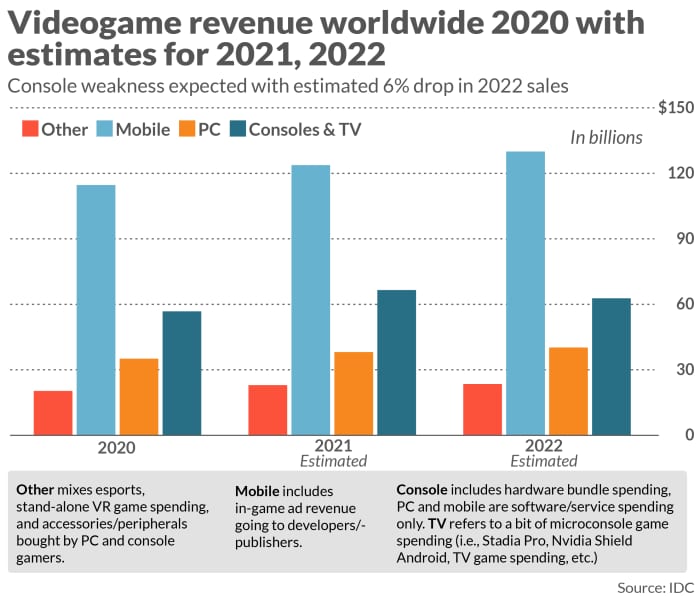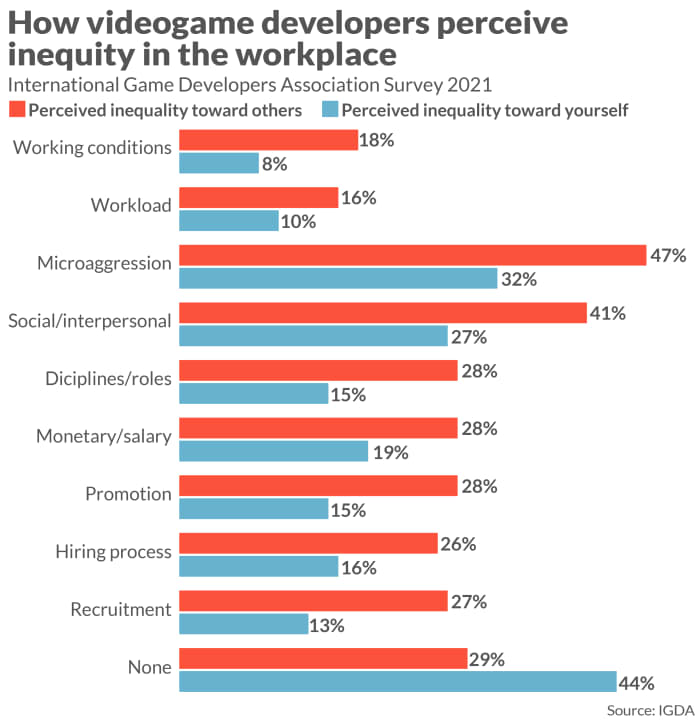This post was originally published on this site
The videogame industry appears to have hit a watershed moment in 2021 that sent a clear message: It’s time to grow up before you can grow any larger.
Allegations of a “frat boy” culture and sexual harassment, rape and discrimination at Activision Blizzard Inc.
ATVI,
became a public-relations nightmare for the videogame publisher, directly affecting the business and ability to produce games, both in keeping current workers productive and attracting and maintaining top talent. The same type of trouble has plagued “Assassin’s Creed” publisher Ubisoft, and “League of Legends” publisher Riot Games, which this week agreed to pay $100 million to settle a discrimination lawsuit.
The videogame industry has grown into one of the largest — if not the largest — entertainment industry categories in the world, far surpassing movies, TV and book publishing, but could be approaching a growth slowdown. While videogame revenues received a huge boost of 24% in 2020 amid stay-at-home mandates due to COVID-19, experts expect that rate of growth to flatten.
Worldwide gaming revenue is expected to come in at $251.39 billion in 2021, according to Lewis Ward, gaming research director at IDC, a gain of 11% compared with 2020’s $226.84 billion. While that’s still pretty healthy growth, Ward expects a more “dramatic” flattening in 2022, when he forecasts revenue of $256.43 billion, or only 2% growth, with an expectation of console/TV sales declining nearly 6% to $62.75 billion in 2022.

IDC
Read more: The pandemic boom in videogames is expected to disappear in 2022
Publishers could counteract that growth, but it will be quite a tightrope: Not only do they have to keep new, high-quality and bug-free content flowing on schedule, but also grow their audience beyond that of stereotypical gamers — generally young males who devote enormous amounts of time playing on consoles or gaming PCs with superfast graphics cards from Nvidia Corp.
NVDA,
or Advanced Micro Devices Inc.
AMD,
The barrier for growth beyond the hardcore gamer is that the decades-old industry was built — fairly exclusively — by those same hardcore gamers, so appealing to other customers and maintaining videogame developers who are not young males has become increasingly difficult. However, the atmosphere at videogame publishers has not been conducive to attracting and supporting a diverse workforce that could develop games for a more diverse customer base, as 2021 showed, leaving a chicken-and-egg problem that will be the focus of 2022.
Read: People are still playing a lot of videogames, but how much?
Toxicity isn’t just bad for the workplace, it’s bad for business
Working in the videogame industry has long trended toward overworked employees in potentially toxic atmospheres. While the industry has managed to grow tremendously, problematic workplaces are beginning to have an adverse effect for publishers looking to recruit and retain their most valuable resource: talented game developers.
One of the challenges that faces videogame publishers is that younger game developers have grown up in atmospheres of equality and inclusion and expect those same values in the workplace, said Kimberly Voll, co-founder of the Fair Play Alliance, an organization that encourages healthy communities in online gaming.
“For companies, it’s becoming a retention aspect,” Voll told MarketWatch in an interview. “The generation coming in today, that’s what they want to see, they’re expecting their employers to have better stances, to have better practices.”
In a developer satisfaction survey released in September, the International Game Developers Association polled 803 developers and found that about 90% believe diversity in the workplace, the industry and in game content itself is important. Diversity took into consideration age, sex, gender (including those that identify as trans or non-binary), race, ethnicity, disability and sexual orientation.
Not surprising was that the survey found that the “prototypical game-industry worker” was a white male in his early 30 with a university degree who lives in North America and has no children. What was a little surprising was that 74% of those polled said there wasn’t equal treatment and opportunities for all in the industry.
“I think the amount of 74% is a bit of surprise,” Renee Gittins, IGDA executive director, told MarketWatch in an interview. “Certainly we’ve not only seen diversity issues and discrimination issues within the industry, we’ve seen a greater awareness of that on the tail of the Activision Blizzard and Riot lawsuits … more people in the industry are becoming aware of those issues.”
In 2021, 44% of respondents said they had never experienced inequity towards themselves and 29% said they had never seen it directed at others, according to IGDA’s survey. In 2019, 51% said they had never been discriminated against and 36% said they had never seen it directed toward others.

IGDA
Non-discrimination and harassment policies were put under the microscope in 2021 to the point in which Activision Blizzard spent the majority of its August earnings call addressing its zero-tolerance behavior policies, while other videogame companies followed suit and highlighted their policies.
Even with zero-tolerance policies in place, however, only 41% of respondents in the 2021 survey felt those policies were enforced, compared with 59% in 2019, and 56% in 2017, according to IGDA.
“I think there’s often a disconnect between company policies and HR policies and the way that companies are actually run,” Gittins said. “And especially in game development, where you have the core employees of the company being passionate, geeky game developers, who are working with each other, sometimes there’s a disconnect between the culture that they create and the culture that the company is trying to create for them.”
So even with companies highlighting their anti-discrimination and harassment policies, Gittins said that “without proper enforcement of that through upper-level management and proper appreciation and cultivation of that culture through all of the employees, then a lot of those end up being empty words.”
Toxicity is also a problem among gamers, now that most videogames network players against other players rather than have them play against a computer. And anonymity behind a screen makes it easier for bad actors to spew out racial and sexual slurs, especially in games that seem to invite such toxic activity.
In a Pew Research survey released in February, polling more than 10,000 adults, 63% said they had experienced offensive name-calling while gaming online, topping all other digital venues included in the survey, such as social media and online discussion sites. Of those polled, 25% said they had experience sustained harassment and 22% reported having received physical threats, according to the survey.
It’s up to videogame publishers to tackle this problem within their networks and also within their games, IGDA said in a recent white paper in a partnership with Facebook
FB,
Gaming. And if the tenor of the game can influence the behavior of the players, then games need to be designed by more diverse teams to grow their customer base.
“A diverse team will innately build a more diverse and inclusive game, as the team members will incorporate their own backgrounds, experiences, ability, heritage and culture into their development process and creations,” according to the white paper. “A team that is diverse and inclusive will tackle problems more effectively and create content that will be enjoyed by a wider audience.”


